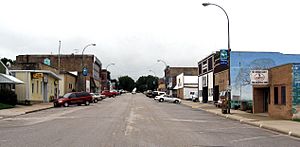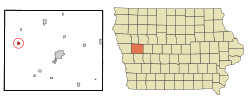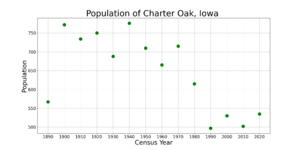Charter Oak, Iowa facts for kids
Quick facts for kids
Charter Oak, Iowa
|
|
|---|---|

Downtown Charter Oak, Iowa
|
|

Location of Charter Oak, Iowa
|
|
| Country | |
| State | |
| County | Crawford |
| Area | |
| • Total | 0.52 sq mi (1.35 km2) |
| • Land | 0.51 sq mi (1.33 km2) |
| • Water | 0.01 sq mi (0.02 km2) |
| Elevation | 1,276 ft (389 m) |
| Population
(2020)
|
|
| • Total | 535 |
| • Density | 1,042.88/sq mi (402.36/km2) |
| Time zone | UTC-6 (Central (CST)) |
| • Summer (DST) | UTC-5 (CDT) |
| ZIP code |
51439
|
| Area code(s) | 712 |
| FIPS code | 19-12900 |
| GNIS feature ID | 2393807 |
| Website | http://www.charteroakia.com/ |
Charter Oak is a small city in Crawford County, Iowa, United States. It is located along the East Soldier River. In 2020, about 535 people lived there.
Contents
History of Charter Oak
Charter Oak was first mentioned in newspapers in 1869. The town's Post Office opened in 1876. A railway line was finished in 1887. This railway brought trains through town twice a day. They carried mail and goods from Manilla to Sioux City. Charter Oak officially became a town in 1891.
It was a busy place with many businesses. These businesses gave jobs to people in the community. The first school was built in 1889. As more people moved to town, the school became too small. The school building used today was built in 1916. In 1929, the first street in Charter Oak was paved.
In 1980, the train service for carrying goods stopped. The railway tracks were removed, and the train station was sold.
Geography of Charter Oak
Charter Oak covers a total area of about 0.48 square miles (1.24 square kilometers). All of this area is land.
Major Highway in Charter Oak
![]() Iowa Highway 141 is an important road that goes through the city.
Iowa Highway 141 is an important road that goes through the city.
People of Charter Oak
The number of people living in Charter Oak has changed over the years. Here's a look at how the population has grown and shrunk:
| Historical populations | ||
|---|---|---|
| Year | Pop. | ±% |
| 1890 | 567 | — |
| 1900 | 772 | +36.2% |
| 1910 | 734 | −4.9% |
| 1920 | 750 | +2.2% |
| 1930 | 688 | −8.3% |
| 1940 | 776 | +12.8% |
| 1950 | 710 | −8.5% |
| 1960 | 665 | −6.3% |
| 1970 | 715 | +7.5% |
| 1980 | 615 | −14.0% |
| 1990 | 497 | −19.2% |
| 2000 | 530 | +6.6% |
| 2010 | 502 | −5.3% |
| 2020 | 535 | +6.6% |
| Source: and Iowa Data Center Source: |
||
2020 Census Information
In 2020, there were 535 people living in Charter Oak. There were 234 households, which are groups of people living together. About 126 of these were families. The city had about 1,042 people per square mile.
Most people in Charter Oak were White (90.7%). A small number were Black or African American (0.6%). Some people were from other races (4.3%) or from two or more races (4.1%). About 7.7% of the people were Hispanic or Latino.
About 29.5% of households had children under 18. Many households (38.9%) were married couples. Some households (46.2%) were not families. About 36.8% of all households had only one person living there.
The average age in the city was 36.2 years old. About 28.8% of residents were under 20. About 17.0% were 65 years old or older. The population was almost evenly split between males (50.8%) and females (49.2%).
2010 Census Information
In 2010, there were 502 people living in Charter Oak. There were 229 households. About 125 of these were families. The city had about 1,045 people per square mile.
Most people in Charter Oak were White (95.6%). A small number were African American (0.6%) or Asian (1.4%). Some people were from other races (1.0%) or from two or more races (1.4%). About 7.2% of the people were Hispanic or Latino.
About 26.6% of households had children under 18. Many households (42.4%) were married couples. About 45.4% of all households were not families. About 41.5% of all households had only one person living there.
The average age in the city was 42.5 years old. About 25.1% of residents were under 18. About 17.9% were 65 years old or older. The population was 47.4% male and 52.6% female.
Education in Charter Oak
The Charter Oak–Ute Community School District serves the area. This district includes Charter Oak, Soldier, and Ute. It operates a public school for students from kindergarten to 8th grade.
For high school, students in grades 9-12 attend school with the Maple Valley-Anthon Oto Community School District. This is part of a special agreement between the two school districts.
Students can also choose to attend schools in other nearby districts. This is called "Open Enrollment." Neighboring districts include Denison Community School District and Boyer Valley Community School District. This option follows specific rules set by Iowa law.
See also
 In Spanish: Charter Oak (Iowa) para niños
In Spanish: Charter Oak (Iowa) para niños


